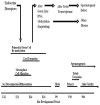Endocrine disruptors and epigenetic transgenerational disease etiology
- PMID: 17413841
- PMCID: PMC5940327
- DOI: 10.1203/pdr.0b013e3180457671
Endocrine disruptors and epigenetic transgenerational disease etiology
Abstract
Exposure to an environmental factor (e.g. endocrine disruptor) during embryonic gonadal sex determination appears to be epigenetically reprogram the male germ-line and subsequently promote transgenerational adult-onset disease. Disease phenotypes resulting from this epigenetic phenomenon include testis abnormalities, prostate disease, kidney disease, tumor development, and immune abnormalities. The epigenetic mechanism is hypothesized to involve the induction of new imprinted-like DNA sequences in the germ-line to transgenerationally transmit disease phenotypes. This epigenetic transgenerational disease mechanism provides a unique perspective from which to view adult onset disease and ultimately offers new insights into novel diagnostic and therapeutic strategies.
Figures


References
-
- Anway MD, Skinner MK. Epigenetic transgenerational actions of endocrine disruptors. Endocrinology. 2006;147:S43–S49. - PubMed
-
- Newbold RR, Hanson RB, Jefferson WN, Bullock BC, Haseman J, McLachlan JA. Increased tumors but uncompromised fertility in the female descendants of mice exposed developmentally to diethylstilbestrol. Carcinogenesis. 1998;19:1655–1663. - PubMed
-
- Zambrano E, Martinez-Samayoa PM, Bautista CJ, Deas M, Guillen L, Rodriguez-Gonzalez GL, Guzman C, Larrea F, Nathanielsz PW. Sex differences in transgenerational alterations of growth and metabolism in progeny (F2) of female offspring (F1) of rats fed a low protein diet during pregnancy and lactation. J Physiol. 2005;566:225–236. - PMC - PubMed
Publication types
MeSH terms
Substances
Grants and funding
LinkOut - more resources
Full Text Sources

